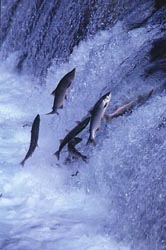Salmon run
Salmon run is the annual migration of salmon from the ocean to the rivers or lakes of their birth in order to spawn. This remarkable journey is a critical phase in the life cycle of salmon and has significant ecological, cultural, and economic implications. Salmon runs occur in the Pacific Ocean and the rivers that flow into it, a region encompassing the western coasts of North America and northeastern Asia.
Overview[edit | edit source]
The salmon run begins when mature salmon, who have spent several years growing in the open ocean, instinctively return to the freshwater bodies where they were hatched. This migration can involve traveling hundreds or even thousands of miles upstream against strong currents and elevation changes. The primary species involved in the salmon run include the Chinook salmon, Coho salmon, Sockeye salmon, Pink salmon, and Chum salmon. Each species has its own unique timing and route for migration, which can vary from late spring to early winter.
Ecological Significance[edit | edit source]
The salmon run plays a crucial role in the ecosystem. As salmon return to their natal rivers to spawn, they bring with them nutrients from the ocean. The death of the salmon after spawning releases these nutrients into the freshwater environment, providing a vital source of nourishment for a wide array of organisms, including insects, birds, and mammals. This nutrient transfer is essential for the health of riparian ecosystems.
Cultural Importance[edit | edit source]
For thousands of years, indigenous peoples of the Pacific Northwest have depended on the salmon run for their way of life. Salmon are central to the diet, culture, and religion of many Native American and First Nations communities. The annual return of the salmon is celebrated and revered, with many traditions and ceremonies centered around the salmon run.
Economic Impact[edit | edit source]
The salmon run also has significant economic benefits. Commercial fishing industries in the Pacific Northwest and Alaska rely heavily on the annual salmon migration. Sport fishing and eco-tourism related to the salmon run further contribute to the economy, drawing visitors from around the world.
Challenges and Conservation[edit | edit source]
Salmon runs face numerous threats, including habitat loss, pollution, overfishing, and climate change. Dams and other barriers can impede migration routes, while rising water temperatures and changing ocean conditions affect salmon survival rates. Conservation efforts focus on habitat restoration, sustainable fishing practices, and the removal or modification of barriers to ensure the survival of salmon populations and the continuation of the salmon run.
Conclusion[edit | edit source]
The salmon run is a natural phenomenon of immense importance. It sustains ecosystems, supports cultures, and drives economies. Protecting this annual migration is essential for the health of the environment and the well-being of future generations.
- Need help finding a doctor or specialist anywhere in the world? WikiMD's DocFinder can help with millions of doctors!
| This article is a stub. Help WikiMD grow by registering to expand it. |
Navigation: Wellness - Encyclopedia - Health topics - Disease Index - Drugs - World Directory - Gray's Anatomy - Keto diet - Recipes
Search WikiMD
Ad.Tired of being Overweight? Try W8MD's physician weight loss program.
Semaglutide (Ozempic / Wegovy and Tirzepatide (Mounjaro) available.
Advertise on WikiMD
WikiMD is not a substitute for professional medical advice. See full disclaimer.
Credits:Most images are courtesy of Wikimedia commons, and templates Wikipedia, licensed under CC BY SA or similar.
Contributors: Prab R. Tumpati, MD






